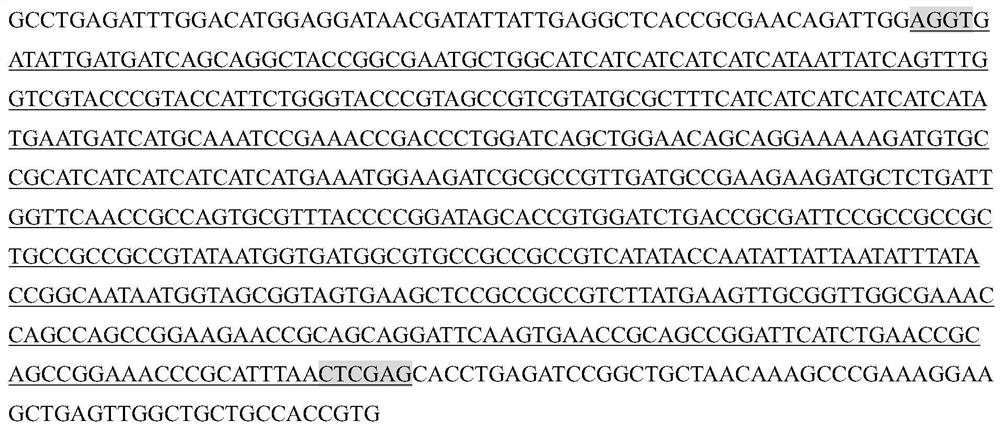Antigen protein, monoclonal antibody or polyclonal antibody thereof and application
A technology of monoclonal antibody and polyclonal antibody, applied in the field of monoclonal antibody or polyclonal antibody and its application, antigen protein, can solve the problem that serological diagnosis has not been widely used, and achieve high sensitivity, strong specificity, good repeatability
- Summary
- Abstract
- Description
- Claims
- Application Information
AI Technical Summary
Problems solved by technology
Method used
Image
Examples
Embodiment 1
[0040] Example 1. Sequence analysis of antigenic protein and expression of antigenic protein
[0041] By comparing the original ORF153 protein (amino acid sequence such as Figure 1A The hydrophobicity, antigenicity and signal peptide analysis of the original ORF153 protein, namely: amino acids 1-44, amino acids 57-75, amino acids 96-123, 146-175 position amino acid, and each remaining amino acid sequence is expressed by connecting 6 histidines (amino acid sequence such as Figure 1B and SEQ ID NO.5), on the one hand, histidine plays the role of connecting the amino acid sequence, and on the other hand, adding histidine is also to use a nickel column when purifying the protein, and finally express the antigen of the sumo-tagged antigen protein ORF153. The results of the characterization analysis showed that it was superior to the original ORF153 protein, and the final expressed recombinant antigen protein with the sumo tag was referred to as ORF153 hereinafter in this applica...
Embodiment 2
[0046] Example 2. Preparation of monoclonal antibodies
[0047] Balb / c mice were immunized with ORF153 protein, the serum titer of the mice was detected by ELSIA, and the serum titer of the mice was detected by extracting the supernatant from the disease material. Antibody pairing experiments.
[0048] 1. Animal immunity
[0049] 5 female BALB / c mice (18±2g) aged 6-8 weeks were selected and immunized with ORF153 protein mixed with Freund's adjuvant, subcutaneously injected with 100ug, and boosted once every 2-3 weeks. After four immunizations, blood was collected for detection, and the titer of mouse antiserum against ORF153 protein was determined by indirect ELISA method, and the titer was normal. The results showed that the immunized mice all produced high-titer antibodies, and the titer of the mouse antiserum was over 1:121,500 whether it was directed against ORF153 or the supernatant of the diseased material.
[0050] 2. Cell fusion
[0051] Mix myeloma cells and immun...
Embodiment 3
[0059] Example 3, polyclonal antibody preparation
[0060] Using ORF153 protein, 2 New Zealand rabbits were immunized, the serum titer of the rabbits was detected by ELSIA, and the rabbit serum titer was detected by extracting the supernatant from the disease material; the rabbit polyclonal antibody was prepared by antigen affinity purification.
[0061] 1. Animal immunity
[0062] After measuring BCA protein concentration with ORF153 protein, 2 New Zealand white rabbits (2-2.5kg) were immunized subcutaneously at 400ug / time, once every 2-3 weeks, and immunized 4 times. The titer of rabbit antiserum against ORF153 protein was determined by indirect ELISA, and the titer was normal. Then, the titer of rabbit antiserum was detected by extracting the supernatant from the disease material, and the titer was normal. The results showed that after immunization, the rabbits all produced high titer antibodies, and the titer of the rabbit antiserum was more than 1:121,500 whether it was ...
PUM
 Login to View More
Login to View More Abstract
Description
Claims
Application Information
 Login to View More
Login to View More - R&D
- Intellectual Property
- Life Sciences
- Materials
- Tech Scout
- Unparalleled Data Quality
- Higher Quality Content
- 60% Fewer Hallucinations
Browse by: Latest US Patents, China's latest patents, Technical Efficacy Thesaurus, Application Domain, Technology Topic, Popular Technical Reports.
© 2025 PatSnap. All rights reserved.Legal|Privacy policy|Modern Slavery Act Transparency Statement|Sitemap|About US| Contact US: help@patsnap.com



